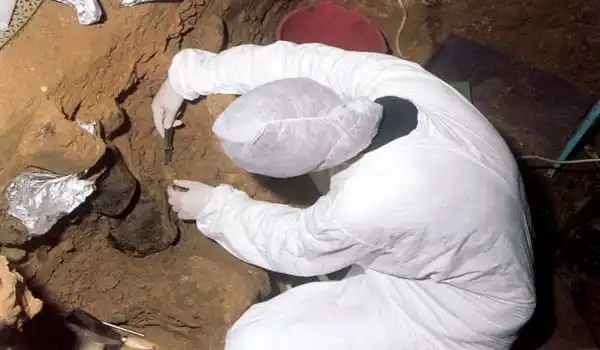The analysis of ancient DNA retained in sediments is a new method that allows the detection of the former presence of humans and other animals at archaeological sites. However, nothing is understood about how DNA is kept in sediment over lengthy periods of time. Scientists have recently thrown light on the matter by isolating DNA from solid slabs of undisturbed sand embedded in plastic resin. The study discovered that ancient human and animal DNA is concentrated in small ‘hot spots’, particularly in minute bone or excrement particles. Micro-sampling of such particles can recover significant amounts of DNA from ancient people, such as Neanderthals, and other species, and relate it to archaeological and ecological records on a microscopic scale.
Most archaeologists have long regarded the sediments in which archaeological objects are embedded as inconsequential byproducts of excavations. However, it has recently been demonstrated that sediments can contain ancient biomolecules such as DNA. “The recovery of ancient human and faunal DNA from sediments provides exciting new opportunities to investigate the geographical and temporal distribution of ancient humans and other organisms at sites where their skeletal remains are rare or absent,” says Matthias Meyer, senior author of the study and researcher at Leipzig’s Max Planck Institute for Evolutionary Anthropology.
The recovery of ancient human and faunal DNA from sediments provides exciting new opportunities to investigate the geographical and temporal distribution of ancient humans and other organisms at sites where their skeletal remains are rare or absent.
Matthias Meye
To understand the origin of DNA in sediment, Max Planck researchers collaborated with an international group of geoarchaeologists (archaeologists who use geological techniques to recreate the creation of sediment and sites) to study DNA preservation in sediment at a microscopic size. They employed undisturbed chunks of silt that had previously been collected from archaeological sites and immersed in synthetic plastic-like (polyester) resin. The solidified blocks were transferred to the laboratory and split into parts for microscopic imaging and genetic research.
The DNA was recovered effectively from a collection of sediment blocks prepared up to 40 years ago from sites in Africa, Asia, Europe, and North America. “The fact that these blocks are a great source of ancient DNA, including that coming from hominins, despite often decades of storage in plastic, provides access to a massive untapped repository of genetic information. The study ushers in a new era of ancient DNA studies that will revisit samples stored in labs, allowing for analysis of sites that have long since been back-filled, which is especially important given travel restrictions and site inaccessibility in a pandemic world” According to Mike Morley of Flinders University in Australia, who led some of the geoarchaeological analyses.

Abundance of micro remains in the sediment matrix
The researchers used sediment blocks from Denisova Cave, a site in the Altai Mountains of South Central Siberia where ancient DNA from Neanderthals, Denisovans, and modern humans has been recovered, and discovered that microscopic organic particles yielded more DNA than silt sampled randomly.
“It clearly shows that the high success rate of ancient mammalian DNA retrieval from Denisova Cave sediments is due to the abundance of micro remains in the sediment matrix rather than free extracellular DNA from feces, bodily fluids, or decomposing cellular tissue potentially adsorbed onto mineral grains,” says Vera Aldeias, co-author of the study and researcher at Portugal’s University of Algarve. “This discovery brings us a lot closer to understanding exactly where and under what conditions ancient DNA is retained in sediments,” Morley adds.
The method described in the study allows for extremely localized micro-scale sediment sampling for DNA studies and demonstrates that ancient DNA (aDNA) is not equally distributed in the sediment and that certain sediment features are more favorable to ancient DNA preservation than others. “By linking sediment aDNA to the archaeological micro-context, we can also address the possibility of physical mobility of aDNA between sedimentary strata,” explains Susan Mentzer, a Senckenberg Centre for Human Evolution and Palaeoenvironment researcher (Germany).
Diyendo Massilani, the study’s lead author, was able to retrieve significant amounts of Neanderthal DNA from only a few milligrams of sediment. He was able to determine the gender of the individuals who left their DNA behind and demonstrated that they belonged to a population related to a Neanderthal whose genome had previously been reassembled from a bone fragment unearthed in the cave.
“The Neanderthal DNA was significantly more concentrated in these little pieces of plastic-embedded sand than we generally detect in loose material,” he explains. “With this method, it will be feasible to study the DNA of many different ancient human beings from a little cube of cemented sediment in the future. It’s interesting to consider that this is most likely because they used the cave as a toilet tens of thousands of years ago.”
















